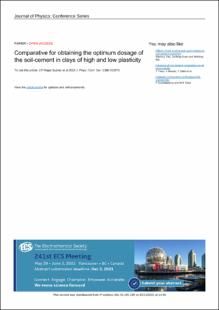Mostrar el registro sencillo del ítem
Comparative for obtaining the optimum dosage of the soil-cement in clays of high and low plasticity
| dc.contributor.author | Rojas Suárez, Jhan Piero | |
| dc.contributor.author | Prada Botia, Gaudy Carolina | |
| dc.contributor.author | Orjuela Abril, Martha Sofia | |
| dc.date.accessioned | 2021-11-22T14:30:16Z | |
| dc.date.available | 2021-11-22T14:30:16Z | |
| dc.date.issued | 2019-11-29 | |
| dc.identifier.uri | http://repositorio.ufps.edu.co/handle/ufps/1214 | |
| dc.description.abstract | Dosage is a technique to modify and improve the conditions of the soil-cement that comply with the conditions of the "Instituto Nacional de Vías" standard and in the same way, is economic to be implemented in different types of clay. The clay was classified depending on its plasticity (high plasticity and low plasticity) and the behavior at loads; making laboratory tests of modified proctor, compaction and CBR% for the clays with 4% of soil cement; at the same time, the results of CBR% of soil cement of 4% with natural soils, of 6% of cement and 1 were compared. In this way, was made a proposal of the elaboration of each type of soil-cement with its respective percentage, concluding that the clay of high plasticity can be used for subgrade and the one of low plasticity has a weak bearing capacity. | eng |
| dc.format.mimetype | application/pdf | spa |
| dc.language.iso | eng | spa |
| dc.publisher | Journal of Physics: Conference Series | spa |
| dc.relation.ispartof | Journal of Physics: Conference Series | |
| dc.rights | Content from this work may be used under the terms of the Creative Commons Attribution 3.0 licence. Any further distribution of this work must maintain attribution to the author(s) and the title of the work, journal citation and DOI. Published under licence by IOP Publishing Ltd | eng |
| dc.source | https://iopscience.iop.org/article/10.1088/1742-6596/1386/1/012079/meta | spa |
| dc.title | Comparative for obtaining the optimum dosage of the soil-cement in clays of high and low plasticity | eng |
| dc.type | Artículo de revista | spa |
| dcterms.references | Šeputytė-Jucik J, Pundienė I, Kičaitė A and Pranckevičienė J 2015 Influence of plasticizer amount on rheological and hydration properties of CEM II type Portland cements IOP Conference Series: Materials Science and Engineering 96 012019 | spa |
| dcterms.references | Chairuddin F and Evelyn 2018 Compression strength testing model on clay soil stabilization using variations of cement composition IOP Conference Series: Materials Science and Engineering 434 012192 | spa |
| dcterms.references | Setiyawan P, Wedyowibowo R and Hawik R 2018 Properties of high strength concrete applied on Semarang - Bawen Highway IOP Conference Series: Earth and Environmental Science 140 012148 | spa |
| dcterms.references | Wijeyesekera D, Ho M, Bai X and Bakar I 2016 Strength and stiffness development in soft soils: A FESEM aided soil microstructure viewpoint IOP Conference Series: Materials Science and Engineering 136 012041 | spa |
| dcterms.references | Andrade F A, Al-qureshi H A and Hotza D 2011 Applied clay science measuring the plasticity of clays: A review Applied Clay Science 51 1 | spa |
| dcterms.references | Hastuty I P, Roesyanto Limbong M N and Oberlyn J 2018 California bearing ratio (CBR) test on stabilization of clay with lime addition IOP Conference Series: Materials Science and Engineering 309 012076 | spa |
| dcterms.references | Hastuty I, Roesyanto I and Simanjuntal O 2018 The stability of clay using Portland cement and calsium carbide residue with California bearing ratio (CBR) value IOP Conference Series: Materials Science and Engineering 126 012019 | spa |
| dcterms.references | Ramírez J C, Osorio H and Parra R 2007 Escalafón de la competitividad de los departamentos en Colombia (Colombia: Naciones Unidas CEPAL) | spa |
| dcterms.references | Instituto Nacional de Vías (INVIAS) 2007 Relaciones de humedad–masa unitaria seca en los suelos, I.N. V. E–141–07 (Colombia: Instituto Nacional de Vías) | spa |
| dcterms.references | Redondo R and Clavijo M 2017 Análsis y comparación de las investigaciones para la obtención de la dosificación optima del suelo cemento en diferentes tipos de arcilla (Colombia: Universidad Francisco de Paula Santander) | spa |
| dcterms.references | Arias J, Cárdenas J and Bautista J 2015 Análisis comparativo para los productos estabilizantes geostab y cemento en la subrasante para el corredor vial Chinácota-Toledo-Monaga, Norte de Santander (Colombia: Universidad Francisco de Paula Santander) | spa |
| dcterms.references | Serran S, Barbosa R and Clavijo D 2016 Dosificación óptima del suelo cemento para la estabilización de una subrasante de 50 metros de tramo ubicado entre Lourdes y Sardinata (Colombia: Universidad Francisco de Paula Santander) | spa |
| dcterms.references | Monsalve L, Giraldo L and Maya J 2012 Diseño de pavimento flexible y rígido (Colombia: Universidad del Quindío) | spa |
| dc.identifier.doi | 10.1088/1742-6596/1386/1/012079 | |
| dc.publisher.place | Londres, Reino Unido | spa |
| dc.relation.citationedition | Vol.1386 No.1.(2019) | spa |
| dc.relation.citationendpage | 7 | spa |
| dc.relation.citationissue | 1 (2019) | spa |
| dc.relation.citationstartpage | 1 | spa |
| dc.relation.citationvolume | 1386 | spa |
| dc.relation.cites | Suárez, J. R., Abril, M. O., & Botía, G. P. (2019, November). Comparative for obtaining the optimum dosage of the soil-cement in clays of high and low plasticity. In Journal of Physics: Conference Series (Vol. 1386, No. 1, p. 012079). IOP Publishing. | |
| dc.relation.ispartofjournal | Journal of Physics: Conference Series | spa |
| dc.rights.accessrights | info:eu-repo/semantics/openAccess | spa |
| dc.rights.creativecommons | Atribución 4.0 Internacional (CC BY 4.0) | spa |
| dc.type.coar | http://purl.org/coar/resource_type/c_6501 | spa |
| dc.type.content | Text | spa |
| dc.type.driver | info:eu-repo/semantics/article | spa |
| dc.type.redcol | http://purl.org/redcol/resource_type/ART | spa |
| oaire.accessrights | http://purl.org/coar/access_right/c_abf2 | spa |
| oaire.version | http://purl.org/coar/version/c_970fb48d4fbd8a85 | spa |
| dc.type.version | info:eu-repo/semantics/publishedVersion | spa |
Ficheros en el ítem
Este ítem aparece en la(s) siguiente(s) colección(ones)
-
EULER [81]










